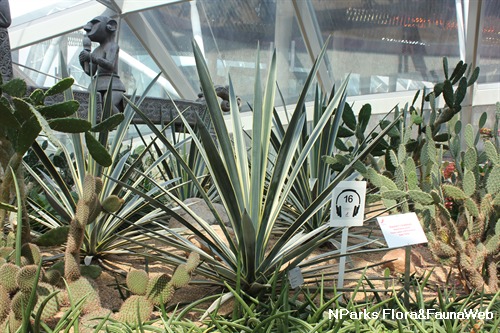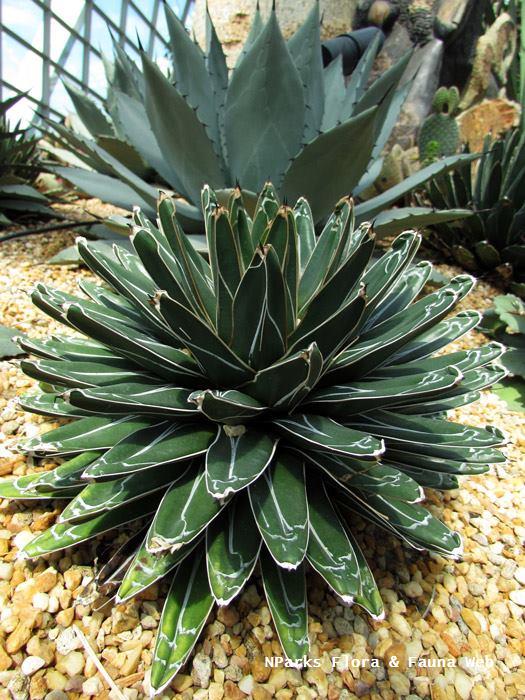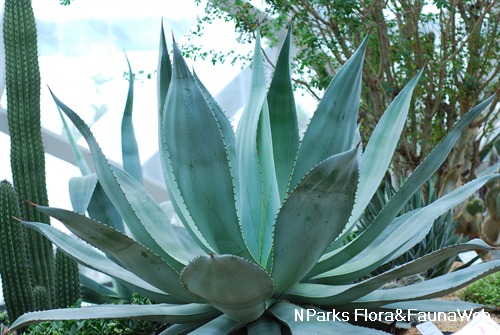
Back
Agave amica 'Sensation'
| Family Name: | Asparagaceae |
| Synonyms: | Polianthes tuberosa 'Sensation' |
| Common Name: | Tuberose, Polianthes |
Agave amica 'Sensation' or Tuberose is a perennial herb of up to 80 cm tall. Leaves are grass-like; linear and narrow with a pointed tip. This cultivar have pink flowers borne on a spike inflorescence. The attractive blooms are one of the popular cut flower grown commercially. Tuberose can also be grown outdoors in containers, along borders or near dining areas to enjoy its highly fragrant flowers that intensifies during the night.
Name
Classifications and Characteristics
| Plant Division | Angiosperms (Flowering Seed Plants) (Monocotyledon) |
|---|---|
| Plant Growth Form | Herbaceous Plant |
Biogeography
| Preferred Climate Zone | Tropical, Temperate |
|---|---|
| Local Conservation Status | Non-native (Horticultural / Cultivated Only) |
Description and Ethnobotany
| Growth Form | It is a tuberous herb that grows to 0.8 m tall. |
|---|---|
| Foliage | Its leaves are grass-like; narrow, linear with a pointed tip clustered at the base of the plant. |
| Flowers | Its flowers are borne on a flower stalk up to 1.2 m tall. Held on a spike inflorescence, this cultivar has pink funnel-shaped flowers which are highly fragrant. Its fragrance is compared to the smell of Gardenia with hints of jasmine, jackfruit and buttered popcorn which intensifies during night time. |
| Fruit | Its fruits are produced in a capsule which spilt upon maturity. |
| Cultivation | Tuberose grow well in most soil types but does best in rich, well-drained soil to avoid 'wet feet' |
| Etymology | The genus 'Polianthes' is derived from the Greek words polios meaning whitish and anthos meaning a flower while its specific epithet refers to tuberous base. |
| Ethnobotanical Uses | Others: Agave amica 'Sensation' is a popular cut-flower grown commercially for its soft pink blooms. |
Landscaping Features
| Desirable Plant Features | Fragrant, Ornamental Flowers |
|---|---|
| Landscape Uses | Container Planting, Flowerbed / Border |
| Thematic Landscaping | Fragrant / Aromatherapy Garden |
Plant Care and Propagation
| Light Preference | Full Sun |
|---|---|
| Water Preference | Moderate Water |
| Plant Growth Rate | Fast |
| Rootzone Tolerance | Acidic (low pH) Soils, Alkaline high pH Soils, Easy to Grow, Fertile Loamy Soils, Well-Drained Soils |
| Propagation Method | Division |
Foliar
| Foliage Retention | Evergreen |
|---|---|
| Mature Foliage Colour(s) | Green |
| Foliar Type | Simple / Unifoliate |
| Foliar Arrangement Along Stem | Basal |
| Foliar Attachment to Stem | Sessile |
| Foliar Margin | Entire |
| Foliar Apex - Tip | Acuminate |
Non - Foliar and Storage
| Stem Type & Modification | Herbaceous |
|---|---|
| Root Type | Underground |
| Specialised Storage Organ(s) | Underground (Root Tuber) |
Floral (Angiosperm)
| Flower & Plant Sexuality | Bisexual Flowers , Bisexual Flowers |
| Flower Colour(s) | Pink |
|---|
| Flower Texture(s) | Waxy |
| Flower Grouping | Cluster / Inflorescence |
| Flower Location | Terminal |
| Flower Symmetry | Radial |
| Individual Flower Shape | Funnelform / Funnel-shaped |
| Inflorescence Type | Spike |
| Flowering Habit | Polycarpic |
Fruit, Seed and Spore
| Fruit Classification | Simple Fruit |
|---|---|
| Fruit Type | Dehiscent Dry Fruit , Dehiscent Dry Fruit |
References
| References | Royal Horticultural Society (continuously updated). RHS Plants. https://www.rhsplants.co.uk/plants/_/polianthes-tuberosa-sensation/classid.2000030709/. Accessed 23 November 2021. Royal Botanic Gardens, Kew (continuously updated). Plants of the World Online | Kew Science. http://powo.science.kew.org/taxon/urn:lsid:ipni.org:names:77153983-1. Accessed 23 November 2021 Missouri Botanical Gardens (continuously updated). Polianthes tuberosa - Plant Finder. https://www.missouribotanicalgarden.org/PlantFinder/PlantFinderDetails.aspx?taxonid=275813&isprofile=0&cv. Accessed 23 November 2021. Lim, T.K (2007). Edible Medicinal and Non-Medicinal Plant, Vol. 7, Flowers, pp 126-128. Springer Dordrecht. |
|---|
Image Repository
Others
| Master ID | 34139 |
|---|---|
| Species ID | 8552 |
| Flora Disclaimer | The information in this website has been compiled from reliable sources, such as reference works on medicinal plants. It is not a substitute for medical advice or treatment and NParks does not purport to provide any medical advice. Readers should always consult his/her physician before using or consuming a plant for medicinal purposes. |

.jpg)



